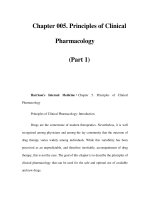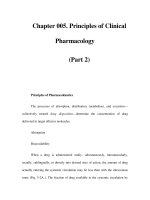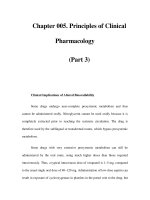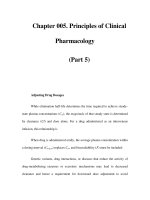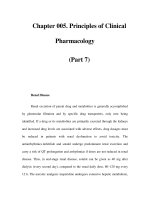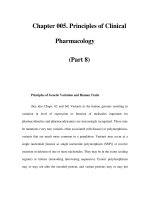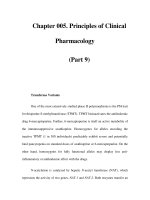Chapter 005. Principles of Clinical Pharmacology (Part 13) docx
Bạn đang xem bản rút gọn của tài liệu. Xem và tải ngay bản đầy đủ của tài liệu tại đây (13.72 KB, 5 trang )
Chapter 005. Principles of Clinical
Pharmacology
(Part 13)
Epidemiology
Patients receive, on average, 10 different drugs during each hospitalization.
The sicker the patient, the more drugs are given, and there is a corresponding
increase in the likelihood of adverse drug reactions. When <6 different drugs are
given to hospitalized patients, the probability of an adverse reaction is ~5%, but if
>15 drugs are given, the probability is >40%. Retrospective analyses of
ambulatory patients have revealed adverse drug effects in 20%. Serious adverse
reactions are also well recognized with "herbal" remedies and OTC compounds:
examples include kava-associated hepatotoxicity, L-tryptophan-associated
eosinophilia-myalgia, and phenylpropanolamine-associated stroke, each of which
has caused fatalities.
A small group of widely used drugs accounts for a disproportionate number
of reactions. Aspirin and other NSAIDs, analgesics, digoxin, anticoagulants,
diuretics, antimicrobials, glucocorticoids, antineoplastics, and hypoglycemic
agents account for 90% of reactions, although the drugs involved differ between
ambulatory and hospitalized patients.
Toxicity Unrelated to a Drug's Primary Pharmacologic Activity
Cytotoxic Reactions
Drugs or more commonly reactive metabolites generated by CYPs can
covalently bind to tissue macromolecules (such as proteins or DNA) to cause
tissue toxicity. Because of the reactive nature of these metabolites, covalent
binding often occurs close to the site of production, typically the liver.
The most common cause of drug-induced hepatotoxicity is acetaminophen
overdosage. Normally, reactive metabolites are detoxified by combining with
hepatic glutathione. When glutathione becomes exhausted, the metabolites bind
instead to hepatic protein, with resultant hepatocyte damage. The hepatic necrosis
produced by the ingestion of acetaminophen can be prevented or attenuated by the
administration of substances such as N-acetylcysteine that reduce the binding of
electrophilic metabolites to hepatic proteins. The risk of acetaminophen-related
hepatic necrosis is increased in patients receiving drugs such as phenobarbital or
phenytoin that increase the rate of drug metabolism or ethanol that exhaust
glutathione stores. Such toxicity has even occurred with therapeutic dosages, so
patients at risk through these mechanisms should be warned.
Immunologic Mechanisms
Most pharmacologic agents are small molecules with low molecular
weights (<2000) and thus are poor immunogens. Generation of an immune
response to a drug therefore usually requires in vivo activation and covalent
linkage to protein, carbohydrate, or nucleic acid.
Drug stimulation of antibody production may mediate tissue injury by
several mechanisms. The antibody may attack the drug when the drug is
covalently attached to a cell and thereby destroy the cell. This occurs in penicillin-
induced hemolytic anemia. Antibody-drug-antigen complexes may be passively
adsorbed by a bystander cell, which is then destroyed by activation of
complement; this occurs in quinine- and quinidine-induced thrombocytopenia.
Heparin-induced thrombocytopenia arises when antibodies against complexes of
platelet factor 4 peptide and heparin generate immune complexes that activate
platelets; thus, the thrombocytopenia is accompanied by "paradoxical" thrombosis
and is treated with thrombin inhibitors. Drugs or their reactive metabolites may
alter a host tissue, rendering it antigenic and eliciting autoantibodies. For example,
hydralazine and procainamide (or their reactive metabolites) can chemically alter
nuclear material, stimulating the formation of antinuclear antibodies and
occasionally causing lupus erythematosus. Drug-induced pure red cell aplasia
(Chap. 102) is due to an immune-based drug reaction. Red cell formation in bone
marrow cultures can be inhibited by phenytoin and purified IgG obtained from a
patient with pure red cell aplasia associated with phenytoin.
Serum sickness (Chap. 311) results from the deposition of circulating drug-
antibody complexes on endothelial surfaces. Complement activation occurs,
chemotactic factors are generated locally, and an inflammatory response develops
at the site of complex entrapment. Arthralgias, urticaria, lymphadenopathy,
glomerulonephritis, or cerebritis may result. Foreign proteins (vaccines,
streptokinase, therapeutic antibodies) and antibiotics are common causes. Many
drugs, particularly antimicrobial agents, ACE inhibitors, and aspirin, can elicit
anaphylaxis with production of IgE, which binds to mast cell membranes. Contact
with a drug antigen initiates a series of biochemical events in the mast cell and
results in the release of mediators that can produce the characteristic urticaria,
wheezing, flushing, rhinorrhea, and (occasionally) hypotension.
Drugs may also elicit cell-mediated immune responses. Topically
administered substances may interact with sulfhydryl or amino groups in the skin
and react with sensitized lymphocytes to produce the rash characteristic of contact
dermatitis. Other types of rashes may also result from the interaction of serum
factors, drugs, and sensitized lymphocytes.

